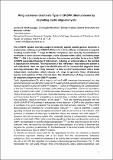Files in this item
Ring nucleases deactivate Type III CRISPR ribonucleases by degrading cyclic oligoadenylate
Item metadata
| dc.contributor.author | Athukoralage, Januka S | |
| dc.contributor.author | Rouillon, Christophe | |
| dc.contributor.author | Graham, Shirley | |
| dc.contributor.author | Grüschow, Sabine | |
| dc.contributor.author | White, Malcolm F | |
| dc.date.accessioned | 2019-03-19T00:38:49Z | |
| dc.date.available | 2019-03-19T00:38:49Z | |
| dc.date.issued | 2018-10-11 | |
| dc.identifier | 255480746 | |
| dc.identifier | 0790a6ad-29ca-45fd-8e3d-10987fc970b1 | |
| dc.identifier | 000446920400055 | |
| dc.identifier | 85054605583 | |
| dc.identifier | 000446920400055 | |
| dc.identifier.citation | Athukoralage , J S , Rouillon , C , Graham , S , Grüschow , S & White , M F 2018 , ' Ring nucleases deactivate Type III CRISPR ribonucleases by degrading cyclic oligoadenylate ' , Nature , vol. 562 , no. 7726 , pp. 277-280 . https://doi.org/10.1038/s41586-018-0557-5 | en |
| dc.identifier.issn | 0028-0836 | |
| dc.identifier.other | ORCID: /0000-0003-1543-9342/work/48516810 | |
| dc.identifier.other | ORCID: /0000-0002-1666-0180/work/60427713 | |
| dc.identifier.uri | https://hdl.handle.net/10023/17311 | |
| dc.description | This work was funded by grants from the Biotechnology and Biological Sciences Research Council (REF BB/M000400/1 and BB/M021017/1). MFW is a Wolfson Research Merit Award holder. | en |
| dc.description.abstract | The CRISPR system provides adaptive immunity against mobile genetic elements in prokaryotes, using small CRISPR RNAs that direct effector complexes to degrade invading nucleic acids1,2,3. Type III effector complexes were recently demonstrated to synthesize a novel second messenger, cyclic oligoadenylate, on binding target RNA4,5. Cyclic oligoadenylate, in turn, binds to and activates ribonucleases and other factors—via a CRISPR-associated Rossman-fold domain—and thereby induces in the cell an antiviral state that is important for immunity. The mechanism of the ‘off-switch’ that resets the system is not understood. Here we identify the nuclease that degrades these cyclic oligoadenylate ring molecules. This ‘ring nuclease’ is itself a protein of the CRISPR-associated Rossman-fold family, and has a metal-independent mechanism that cleaves cyclic tetraadenylate rings to generate linear diadenylate species and switches off the antiviral state. The identification of ring nucleases adds an important insight tothe CRISPR system. | |
| dc.format.extent | 16 | |
| dc.format.extent | 4390628 | |
| dc.language.iso | eng | |
| dc.relation.ispartof | Nature | en |
| dc.subject | Archaeon sulfolobus-solfataricus | en |
| dc.subject | CAS systems | en |
| dc.subject | Image-analysis | en |
| dc.subject | Mechanism | en |
| dc.subject | Classification | en |
| dc.subject | Discovery | en |
| dc.subject | Immunity | en |
| dc.subject | RNA | en |
| dc.subject | R Medicine (General) | en |
| dc.subject | DAS | en |
| dc.subject | BDC | en |
| dc.subject | R2C | en |
| dc.subject.lcc | R1 | en |
| dc.title | Ring nucleases deactivate Type III CRISPR ribonucleases by degrading cyclic oligoadenylate | en |
| dc.type | Journal article | en |
| dc.contributor.sponsor | BBSRC | en |
| dc.contributor.sponsor | BBSRC | en |
| dc.contributor.sponsor | The Royal Society | en |
| dc.contributor.institution | University of St Andrews. School of Biology | en |
| dc.contributor.institution | University of St Andrews. Biomedical Sciences Research Complex | en |
| dc.identifier.doi | https://doi.org/10.1038/s41586-018-0557-5 | |
| dc.description.status | Peer reviewed | en |
| dc.date.embargoedUntil | 2019-03-19 | |
| dc.identifier.url | https://doi.org/10.1101/380436 | en |
| dc.identifier.grantnumber | BB/M021017/1 | en |
| dc.identifier.grantnumber | BB/M000400/1 | en |
| dc.identifier.grantnumber | WM140004 | en |
This item appears in the following Collection(s)
Items in the St Andrews Research Repository are protected by copyright, with all rights reserved, unless otherwise indicated.

